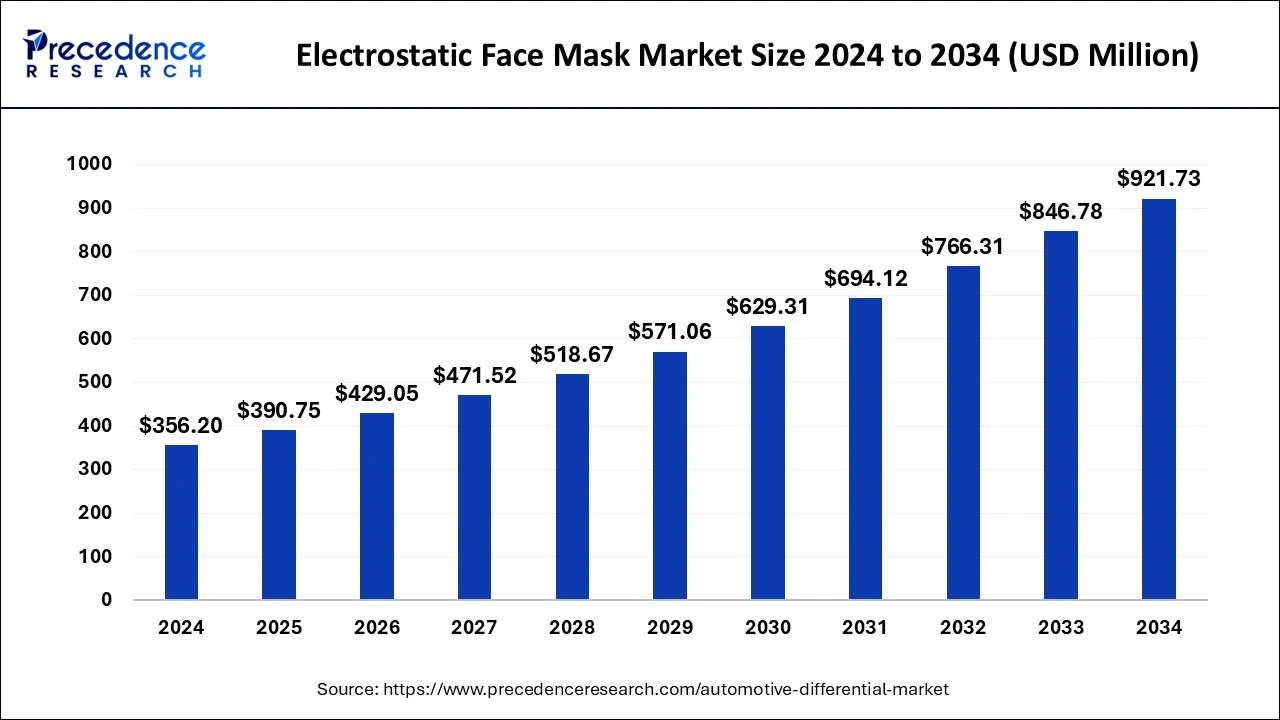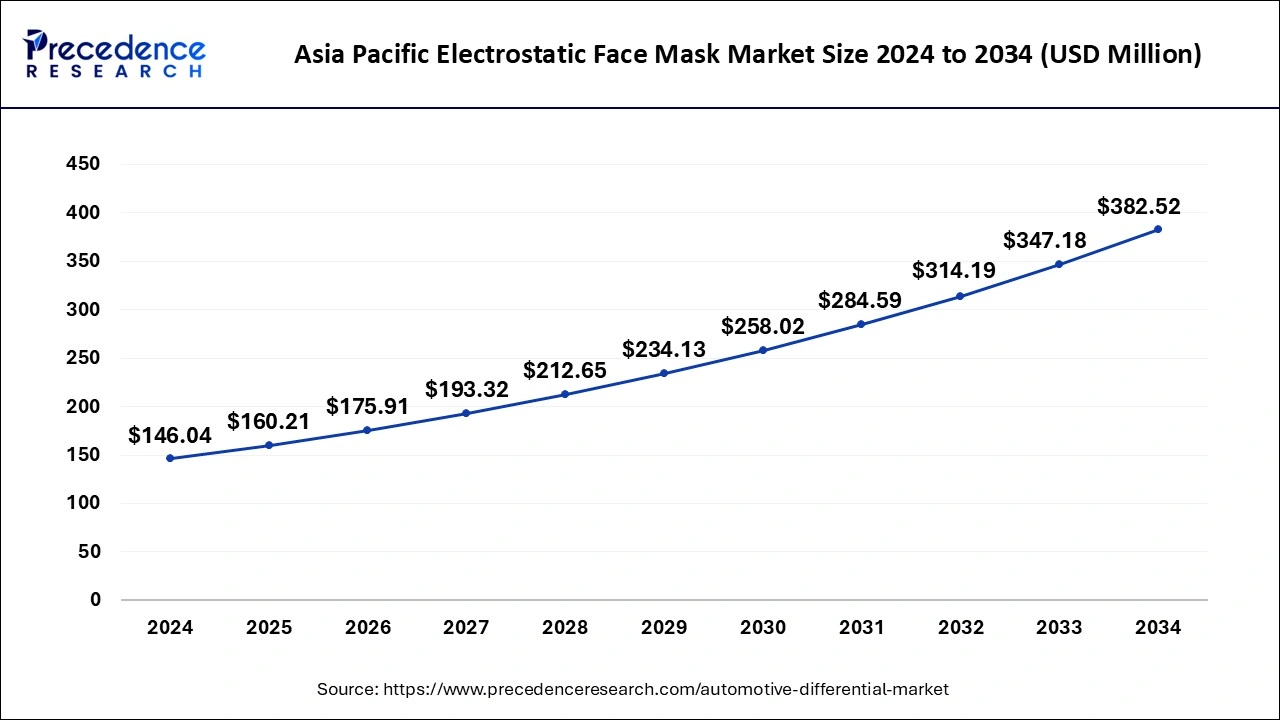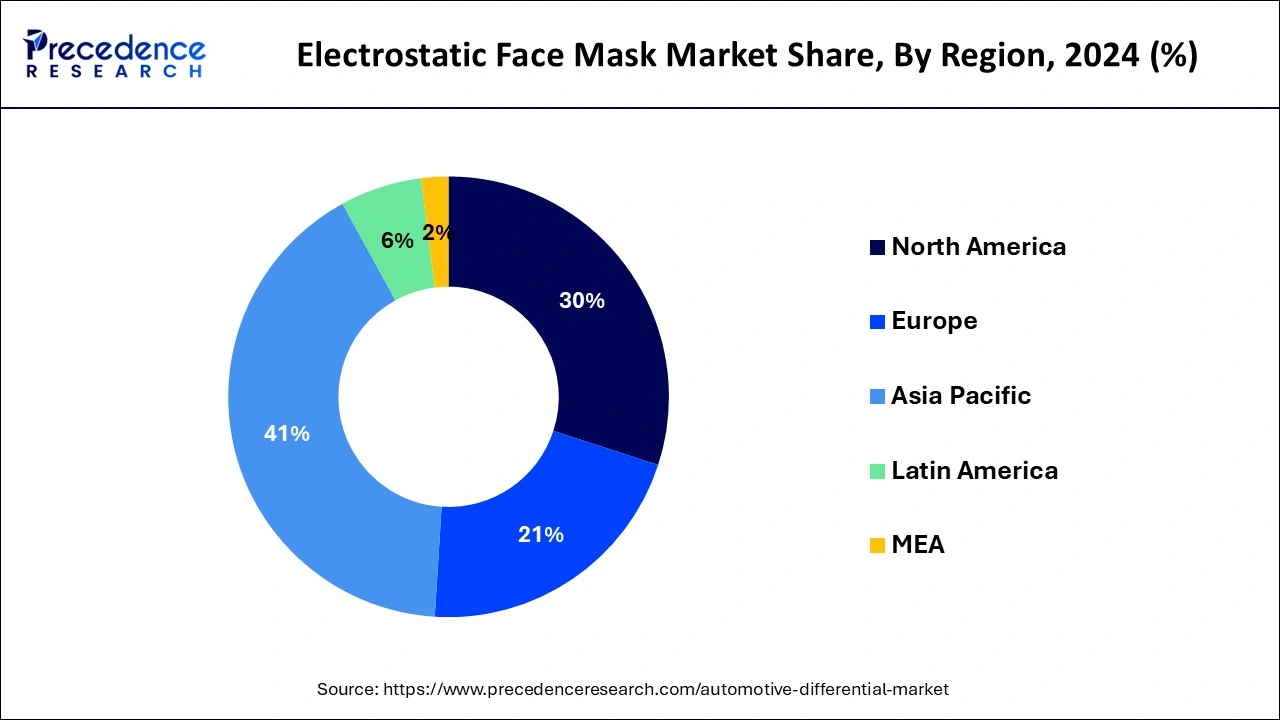List of Contents
Electrostatic Face Mask Market Size and Forecast 2025 to 2034
The global electrostatic face mask market size was calculated at USD 356.20 million in 2024 and is predicted to increase from USD 390.75 million in 2025 to approximately USD 921.73 million by 2034, expanding at a CAGR of 9.97% from 2025 to 2034.

Electrostatic Face Mask MarketKey Takeaways
- The global electrostatic face mask market was valued at USD 356.20 million in 2024.
- It is projected to reach USD 921.73 million by 2034.
- The electrostatic face mask market is expected to grow at a CAGR of 9.97% from 2025 to 2034.
- Asia-Pacific contributed more than 41% of market share in 2024.
- North America is estimated to expand at the fastest CAGR between 2025 and 2034.
- By product type, the disposable segment held the largest market share of 56% in 2024.
- By product type, the reusable segment is anticipated to grow at a remarkable CAGR of 11.18% between 2025 and 2034.
- By application, the healthcare segment generated over 32% of the market share in 2024.
- By application, the commercial segment is expected to expand at the fastest CAGR over the projected period.
- By distribution channel, the offline segment generated over 54% of the market share in 2024.
- By distribution channel, the online segment is expected to expand at the fastest CAGR over the projected period.
Asia-PacificElectrostatic Face Mask Market Size and Growth 2025 to 2034
The Asia-Pacific electrostatic face mask market size was exhibited at USD 146.04 million in 2024 and is projected to be worth around USD 382.52 million by 2034, growing at a CAGR of 10.11% from 2025 to 2034.

In 2024, Asia-Pacific held a share of 41% in the electrostatic face mask market due to rapid industrialization, increasing pollution levels, and a large population. The region's proactive response to public health challenges, coupled with rising awareness of respiratory protection, drives demand. Growing urbanization and healthcare infrastructure development further contribute to the adoption of advanced face masks. Additionally, the flourishing manufacturing sector and technological advancements in countries like China and Japan bolster the market. The vast consumer base and diverse applications across industries solidify Asia-Pacific's major position in the electrostatic face mask market.

North America is projected to witness rapid growth in the electrostatic face mask market due to heightened awareness of respiratory health, stringent safety regulations, and the region's robust healthcare infrastructure. Increasing pollution levels and a proactive response to pandemic challenges contribute to the growing demand for advanced respiratory protection. Additionally, a tech-savvy population's preference for innovative solutions further fuels market growth. These factors, combined with a flourishing e-commerce sector facilitating easy access to electrostatic masks, position North America as a key market for the industry's expansion.
Meanwhile, Europe is experiencing notable growth in the electrostatic face mask market due to a heightened emphasis on public health and safety. The region's response to the COVID-19 pandemic has increased awareness about the importance of respiratory protection. Stricter air quality regulations and rising pollution levels further drive the demand for advanced face masks. Additionally, European consumers' inclination towards sustainable and innovative products aligns with the features of electrostatic masks. These factors collectively contribute to the significant expansion of the electrostatic face mask market in the European region.
Market Overview
An electrostatic face mask is a special type of protective mask designed to efficiently filter out airborne particles, such as dust, pollutants, and viruses. Unlike regular masks, electrostatic masks utilize electrostatic charges to attract and capture tiny particles, enhancing their filtration capabilities. The mask typically consists of multiple layers, including a charged layer that attracts particles with opposite charges. This electrostatic attraction helps to trap even smaller particles that might otherwise pass through conventional masks. As a result, electrostatic face masks provide a higher level of protection against fine particles and airborne contaminants. These masks are particularly beneficial in environments with elevated pollution levels or during outbreaks of respiratory infections, offering a more effective barrier to ensure the wearer's respiratory health.
Electrostatic Face Mask Market Data and Statistics
- The World Health Organization's estimation of a 40% increase in face mask production underscores the urgent need to address the global shortage exacerbated by the COVID-19 pandemic. The widespread nature of the virus, affecting over 213 countries, has prompted numerous governments to impose export bans on personal protective equipment, including face masks. This has led to a significant supply-demand gap, prompting companies worldwide to intensify their efforts to meet the escalating need for face masks.
- By May 2020, more than 75 countries had mandated the use of face masks, reflecting a global acknowledgment of their importance in controlling the virus's spread. Remarkably, around 88% of the world's population resided in countries where the use of face masks in public settings was recommended.
Electrostatic Face Mask Market Growth Factors
- The awareness regarding the transmission of airborne diseases, including respiratory viruses, has surged. Events like the COVID-19 pandemic have underscored the importance of effective face masks. Studies show that the use of electrostatically charged masks significantly reduces the risk of viral transmission compared to traditional masks.
- Ongoing advancements in mask technology, such as improved electrostatic filtration materials, contribute to market growth. Innovations like triboelectric nanogenerators enhance the electrostatic properties of masks, increasing their efficiency. These advancements attract consumers seeking cutting-edge solutions for respiratory protection.
- Stringent regulations and guidelines regarding occupational safety, particularly in industries with high levels of airborne particles, drive the adoption of electrostatic face masks. Compliance with these regulations fuels the market as businesses invest in quality respiratory protection for their workers.
- Increased healthcare spending globally, driven by a growing emphasis on public health and safety, supports the electrostatic face mask market. Governments and private entities allocate funds to procure advanced respiratory protection equipment, contributing to market expansion.
- The demand for masks that provide both effective protection and comfort has grown. Electrostatic face masks, with their improved filtration efficiency and often sleek designs, appeal to consumers who prioritize safety without compromising on comfort or style. This preference boosts market growth as individuals seek masks that align with their lifestyle choices.
Market Scope
| Report Coverage | Details |
| Growth Rate from 2025 to 2034 | CAGR of 9.97% |
| Market Size in 2025 | USD 390.75 Million |
| Market Size by 2034 | USD 921.73 Million |
| Base Year | 2024 |
| Forecast Period | 2025 to 2034 |
| Segments Covered | Product Type, Application, and Source |
| Regions Covered | North America, Europe, Asia-Pacific, Latin America, and Middle East & Africa |
Market Dynamics
Driver
Increasing air pollution levels
- According to the World Health Organization (WHO), 91% of the world's population lives in areas where air quality exceeds the guideline limits, creating a substantial market for enhanced respiratory protection.
The surge in market demand for electrostatic face masks is closely tied to the escalating levels of air pollution globally. As industrialization and urbanization intensify, the concentration of pollutants in the air rises, posing significant health risks. This heightened air pollution has led to an increased awareness of the need for effective respiratory protection. Electrostatic face masks, with their advanced filtration technology, become a sought-after solution in such environments. People are increasingly recognizing the importance of safeguarding their respiratory health amid rising pollution levels.
Electrostatic face masks, equipped with specialized filters that utilize electrostatic charges to attract and capture fine particles, offer enhanced protection against airborne pollutants. As the demand for cleaner air solutions grows in tandem with worsening pollution, the electrostatic face mask market experiences a surge, with individuals and industries alike prioritizing these masks to ensure effective respiratory safety in polluted environments.
Restraint
Limited breathability
Limited breathability poses a notable restraint to the market demand for electrostatic face masks. While these masks excel in filtration efficiency, some users experience discomfort due to reduced airflow. The advanced filtration layers that make electrostatic masks effective in trapping tiny particles can, in turn, restrict the ease of breathing, especially during prolonged use. This limitation becomes particularly significant in scenarios where individuals need to wear masks continuously, such as in work environments or healthcare settings, leading to potential dissatisfaction among users.
The preference for comfort is a crucial factor in consumer choices, and masks perceived as less breathable may discourage widespread adoption. Individuals may opt for alternative face mask options that strike a better balance between effective filtration and breathability, impacting the overall market demand for electrostatic face masks. Addressing breathability concerns through continuous product innovation and design improvements will be essential for overcoming this specific restraint and ensuring broader acceptance in the market.
Opportunity
Healthcare sector adoption
Healthcare sector adoption serves as a significant opportunity for the electrostatic face mask market. These masks, known for their enhanced filtration capabilities, are gaining traction in healthcare settings where stringent infection control measures are essential. The demand for reliable respiratory protection for healthcare professionals and patients creates a substantial market niche. Electrostatic face masks provide an advanced defense against airborne particles, including viruses, contributing to a safer healthcare environment.
As awareness of respiratory health grows, healthcare institutions are increasingly recognizing the benefits of electrostatic face masks in preventing the spread of infectious diseases. The ongoing emphasis on personal protective equipment (PPE) in healthcare settings, coupled with the need for effective solutions during global health crises, positions the electrostatic face mask market to capitalize on the healthcare sector's demand. This adoption not only enhances the safety of healthcare workers but also presents a valuable market opportunity for manufacturers and suppliers catering to the unique needs of the healthcare industry.
Product Type Insights
The disposable segment held the highest market share of 56% in 2024. In the electrostatic face mask market, the disposable segment refers to masks designed for one-time use, offering convenient and hygienic solutions. This segment is witnessing a rising trend as disposable electrostatic face masks provide a hassle-free option for users, especially in healthcare and general public settings. The demand for disposable electrostatic masks is driven by their ease of use, accessibility, and the need for quick, efficient protection against airborne particles, making them a preferred choice in various industries and daily activities.
The reusable segment is anticipated to witness rapid growth at a significant CAGR of 11.18% during the projected period. The reusable segment in the electrostatic face mask market refers to masks designed for multiple uses with the capability to withstand cleaning and maintenance. These masks typically feature durable materials, such as washable fabrics and replaceable filters, offering a sustainable and cost-effective solution. The trend in the reusable segment involves a growing emphasis on eco-friendly materials, stylish designs, and user-friendly features. Manufacturers are focusing on creating aesthetically pleasing, comfortable, and effective reusable electrostatic face masks to meet consumer demands for both respiratory protection and sustainability.
Application Insights
The healthcare segment has held a 32% market share in 2024. In the electrostatic face mask market, the healthcare segment refers to the use of these masks in medical settings to protect healthcare professionals and patients from airborne contaminants. A notable trend in this segment involves the increasing adoption of electrostatic face masks in hospitals, clinics, and other healthcare facilities. The demand is driven by the masks' superior filtration efficiency against viruses and particles, aligning with the stringent infection control measures essential in healthcare environments, especially during global health crises like the COVID-19 pandemic.
The commercial segment is anticipated to witness rapid growth over the projected period. In the electrostatic face mask market, the commercial segment refers to the use of these masks in various business and commercial settings. This includes offices, retail establishments, hospitality, and other non-industrial environments. A notable trend in this segment involves businesses prioritizing employee and customer safety, leading to increased adoption of electrostatic face masks. As workplaces focus on creating safe environments, the demand for advanced respiratory protection in commercial spaces is expected to continue, driving the growth of electrostatic face masks within the commercial segment.
Distribution Channel Insights
The offline segment held a 54% market share in 2024. In the electrostatic face mask market, the offline distribution channel refers to traditional brick-and-mortar retail outlets, pharmacies, and healthcare supply stores where consumers can physically purchase masks. Despite the growing prevalence of online sales, the offline segment remains significant for immediate accessibility, especially in emergency situations. Trend-wise, the offline channel emphasizes strategic partnerships with healthcare institutions, ensuring a steady supply of electrostatic face masks to hospitals and clinics. Additionally, retailers are focusing on clear and informative in-store displays to educate consumers about the benefits and proper usage of electrostatic face masks.
The online segment is anticipated to witness rapid growth over the projected period. The online distribution segment in the electrostatic face mask market refers to the sale and purchase of these masks through various digital platforms. The trend in this segment is marked by the increasing popularity of online retail channels, providing consumers with convenient access to a diverse range of electrostatic face masks. E-commerce platforms, company websites, and online marketplaces have become pivotal channels, offering a seamless buying experience, product information, and customer reviews, contributing to the growing prominence of online distribution in the electrostatic face mask market.
Recent Developments
- In May 2022, Honeywell made strategic advancements by unveiling two new NIOSH-certified respirators. The first addition, the DC365 compact surgical N95 respirator, caters specifically to the increasing needs of healthcare professionals.
Electrostatic Face Mask Market Companies
- 3M Company
- Honeywell International Inc.
- Kimberly-Clark Corporation
- Moldex-Metric, Inc.
- Alpha Pro Tech, Ltd.
- DuPont de Nemours, Inc.
- Ansell Limited
- Drägerwerk AG & Co. KGaA
- Prestige Ameritech
- Medicom Group
- UVEX ARBEITSSCHUTZ GmbH
- Irema Ireland
- The Gerson Company
- DACH Schutzbekleidung GmbH & Co. KG
- Foss Performance Materials (Part of Ahlstrom-Munksjö Group)
Segments Covered in the Report
By Product Type
- Disposable
- Reusable
By Application
- Healthcare
- Industrial
- Commercial
- Personal
By Source
- Online
- Offline
By Geography
- North America
- Europe
- Asia-Pacific
- Latin America
- Middle East and Africa
For inquiries regarding discounts, bulk purchases, or customization requests, please contact us at sales@precedenceresearch.com
Frequently Asked Questions
Ask For Sample
No cookie-cutter, only authentic analysis – take the 1st step to become a Precedence Research client